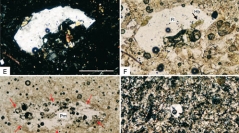

 Geodiversitas
27 (4) - Pages 553-566
Geodiversitas
27 (4) - Pages 553-566The Neogene tuffs of the Akkașdağı region, in the south eastern part of the Çankırı-Çorum Basin in Central Anatolia, yielded one of the richest mammalian faunas of Turkey. The main aim of the present study is to provide data on the distribution, age, petrographical, mineralogical and geochemical composition of these tuffs. It is shown that they are primary products of a volcanic process. The Akkașdağı tuffs are included in a late Miocene sedimentary sequence and were deposited as pyroclastic flow deposits. The gas escape structures (gas segregation pipes) in tuffs and the abundance of pumice and lithic clasts in the lower parts should be mentioned. The age of the tuffs is determined as late Miocene (MN 12 zone) based on the rich mammalian fauna and as 7.1 ± 0.1 Ma on the basis of radiometric dating. The petrographic investigations indicated that the Akkașdağı tuffs are vitric tuffs. Biotite and lithic clasts occur in a glassy matrix. In addition, they contain feldspar (orthoclase), quartz phenocrysts, oxyhornblende and pumice clasts. With these properties, the tuffs present all characteristics of ignimbrites. Geochemical analyses reveal the calc-alkaline nature and rhyolitic composition of these tuffs. These results show that the Akkașdağı tuffs show similarities to those of the Nevs.ehir Plateau which belong to the Central Anatolian Volcanic Province. Because these tuffs are pyroclastic flow deposits, it is thought that the source area should be close to Akkașdağı. Volcanic activity might have caused the mass death of mammals the remains of which are concentrated in several bone pockets.
Tuff, geochemical analyses, radiometric dating, late Miocene, Akkașdağı, Central Anatolia, Turkey